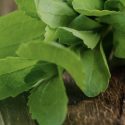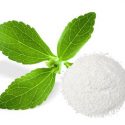What are Steviol glycosides (E960) in Stevia leaf? Types, Uses and Safety

Steviol glycosides Types | Production | Uses | Safety
Steviol glycosides also known as stevia extract or stevia sweetener, are a series of high intensity sweeteners naturally and together present in the leaves of stevia (Stevia rebaudiana Bertoni). Their sweetness is around 200-300 times sweeter than sucrose (table sugar).
With the advantage of zero calorie, does not raise blood sugar (glycemic index 0) and extracted from a natural plant source, it is widely used in sugar-free and reduced-calorie food & beverage, with the European food additive number E960.
Steviol glycosides Types
There are 11 types of steviol glycosides approved by the EU (1).
Stevioside and rebaudioside A are the primary sweetening compounds, and others are minor occurring ingredients in the leaves of Stevia rebaudiana Bertoni. These steviol glycosides are the glycosides of steviol, differ in molecular structure but all have the same basic backbone called steviol.
Their difference lies in the type and number of glucose moieties bound to the glycosidic bond in C-13 and C-19, which contributes to their own chemical structure and taste.
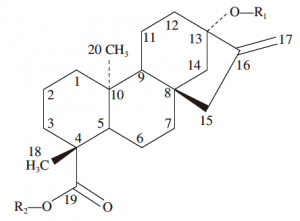
Steviol chemical structure
It seems the more the number of glucose moieties, the better sweet, and less bitter taste of the steviol glycoside. Stevioside has three, rebaudioside A has four and rebaudioside M has six glucose moieties. Among the three, reb M tastes the best, reb A next and then stevioside.
Stevia leaves contain 6%-10% stevioside, 2%-4% rebaudioside A and 1%-2% other minor steviol glycosides (rebaudioside B, C, D, E, F and M, steviolbioside, rubusoside and dulcoside A).
At present, more than 70 individual steviol glycosides have been discovered but most of them lack relevant sweetness data due to their low content.
The following are the 11 types of steviol glycosides:
- Stevioside
- Rebaudioside A
- Rebaudioside B
- Rebaudioside C
- Rebaudioside D
- Rebaudioside E
- Rebaudioside E
- Rebaudioside M
- Steviolbioside
- Rubusoside
- Dulcoside A
Among them, the percentage of stevioside accounts for about 60%-70% of the total steviol glycosides, followed by rebaudioside A, which accounts for about 15% to 20%, and the third is rebaudioside C, the content is about 5%.
Stevioside
Stevioside was first used because it is the primary extract in stevia leaves and its sweetness is about 250 times that of sucrose. Commonly it is a mixture.
Although the content is highest in steviol glycosides, the strong bitter and astringent aftertaste limits its applications in food. Therefore, commonly it is used in conjunction with other sweeteners or sugars to taste better.
Molecular formula C38H60O18, molecular weight 805.
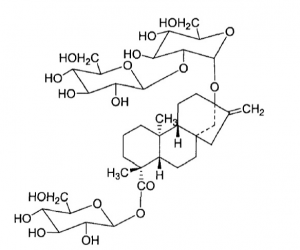
Stevioside chemical structure
Rebaudioside A
Rebaudioside A, an ideal natural sweetener to replace sucrose and it is the most widely used steviol glycoside today. However, it still has a taste profile of slow onset, bitterness and a lingering aftertaste, but better than stevioside.
The sweetness of reb A is around 350 times that of sucrose, and the taste is close to that of sucrose. This makes it can be used in a lot of food and beverage.
Molecular formula of C44H70O23, molecular weight 967.

Rebaudioside A chemical structure
Rebaudioside M
Rebaudioside M in stevia accounts for less than 0.05% of the total steviol glycosides, its sweetness is about 200 times than that of sucrose.
Rebaudioside M provides a cleaner and more sugar-like taste than reb A. It is very suitable to be used in a variety of food and beverage products.
Molecular formula C56H90O33, molecular weight 1291.
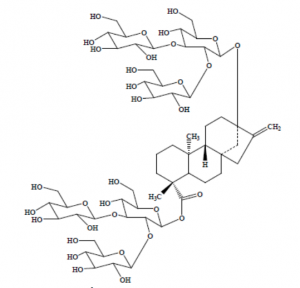
Rebaudioside M chemical structure Source
Rebaudioside B
Rebaudioside B has a better taste than reb A. It can be used to replace reb A to sweeten food or beverage. When reb A and reb B used together, the food taste can be improved. (2)
Chemical formula C38H60O18, Molecular weight 804.88
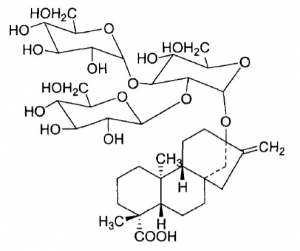
Rebaudioside B chemical structure
Rebaudioside C
150 times that of sucrose, chemical formula C44H70O22, molecular weight 951.01.
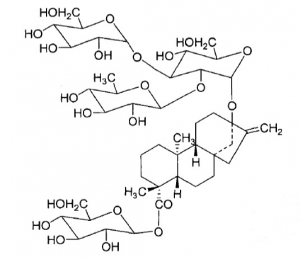
Rebaudioside C chemical structure
Rebaudioside D
250 times sweeter than that of sucrose, the taste of rebaudioside D is better than rebaudioside A, and the bitterness is significantly lower than that of rebaudioside A.
Rebaudioside D in stevia accounts for 0.3% to 0.8% of the total steviol glycoside content.
Molecular formula C50H80O28, molecular weight 1129.
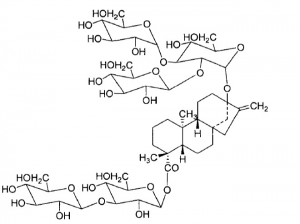
Rebaudioside D chemical structure
Rebaudioside E
Chemical formula C44H70O23, Molecular weight 967.01
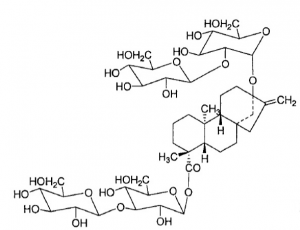
Rebaudioside E chemical structure
Rebaudioside F
Chemical formula C43H68O22, Molecular weight 936.9
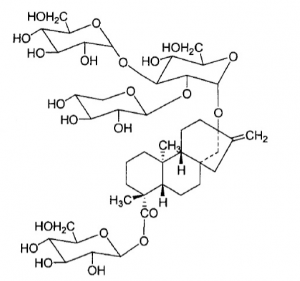
Rebaudioside F chemical structure
Steviolbioside
Chemical formula C32H50O13, Molecular weight 642.73
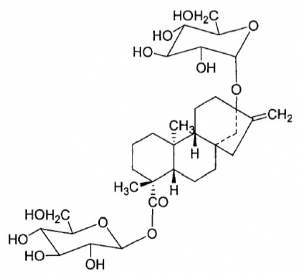
Steviolbioside chemical structure
Rubusoside
Chemical formula C32H50O13, Molecular weight 642.73
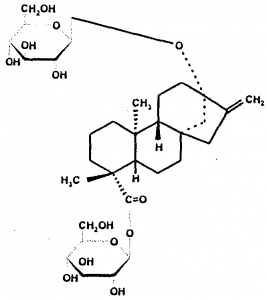
Rubusoside chemical structure Source
Dulcoside A
Chemical formula C38H60O17, Molecular weight 788.87

Dulcoside A chemical structure
How are Steviol glycosides Made?
Steviol glycosides are natural sweeteners made from stevia leaves (stevia rebaudiana Bertoni) through a series of processes such as water/alcohol extraction, impurity removal, decolorization, and drying.
What’re the Uses of Steviol glycosides?
As a plant-derived sweetener, they’re known as the third natural sweetener after sucrose and beet sugar. It has been eaten for hundreds of years in many countries. People in the origin of steviol glycosides used to add it to tea to increase the sweetness.
Food & Beverage
Steviol glycosides are non-nutritive sweeteners that can be used as the alternatives for artificial sweeteners (e.g. aspartame, acesulfame k, sucralose, saccharin, neotame), and with the properties of 200 to 300 times than sugar, zero calorie, zero glycemic index, does not cause tooth decay, does not raise blood sugar and suitable for diabetics, it is suitable to produce energy reduction and sugar free food.
Steviol glycosides are widely used in foods such as carbonated soft drinks, dairy products, tea, juice, bakery, confectionery, pickles, desserts, and etc. They’re often combined with artificial sweeteners.
Pharmaceuticals
Steviol glycosides can be added to some medicines to replace sucrose. Take syrup as an example, the sugar content in syrup is quite high, up to 65%. Such high sugar content may be bad for our health and unavailable to diabetic patients. Adding stevia to some syrup can improve this shortcoming.
Are Steviol glycosides safe to eat?
Yes, almost no side effects and their safety as food additives have been approved by the U.S. Food and Drug Administration (FDA), European Food Safety Authority (EFSA), Joint FAO/WHO Expert Committee on Food Additives (JECFA), UK Food Standards Agency (FSA), as well as Food Standards Australia New Zealand (FSANZ).
High-purity (95% minimum purity) of individual or combined steviol glycosides can be considered as GRAS by the FDA, while stevia leaf and crude stevia extracts are not. (3)
In the safety evaluation of steviol glycosides in 2010, EFSA claimed they were not carcinogenic, genotoxic or associated with any reproductive/developmental toxicity. Meanwhile, EFSA established an ADI of 4 mg/kg bw/day for steviol glycosides, expressed as steviol. (4)
JECFA set a temporary ADI of 0-2 mg/kg bw in 2007, and improved the ADI to 0-4 mg/kg bw in 2008. (5)
FSANZ approves steviol glycosides both sourced from the leaves of the stevia plant and produced by bioconversion of the plant extract. (6)
Conclusion
Now you may have a knowledge of the high intensity sweetener – Steviol glycosides (E960), from the following aspects:
- 11 types and their difference, especially stevioside, rebaudioside A and rebaudioside M
- Production process
- Uses
- Safety
What kinds of food labels have you found this ingredient in? Or if you have any questions or remarks about this additive, feel free to let me know in the comments.
Featured Image Source

